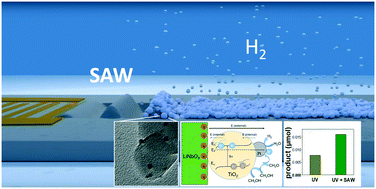Surface acoustic wave enhanced water splitting reaction with methanol as a sacrificial material†
Abstract
TiO2 is the most widely used photocatalyst for the water splitting reaction to generate the clean fuel hydrogen, but its energy conversion efficiency is still low, mainly due to the easy recombination of photo-generated electron–hole pairs. In order to promote the efficiency of the catalyst, a surface acoustic wave assisted catalyst is presented in this study. On 128° rotated y-cut LiNbO3, Rayleigh waves with a frequency of 150 MHz are generated and act on Pt modified TiO2 catalyst nanoparticles. We here quantify the effect of the application of surface acoustic waves to a Pt/TiO2 catalyst for hydrogen production by photo-splitting of a methanol/water vapor mixture. The results convincingly show that the photocatalytic activity of Pt/TiO2 is clearly enhanced by the SAW propagation underneath the catalyst layer. The effect increases nonlinearly with the applied power level of the acoustic waves. As the main mechanism, we identify the electric field produced by the displacement of LiNbO3, which hinders the recombination of photo-generated electron–hole pairs.



 Please wait while we load your content...
Please wait while we load your content...